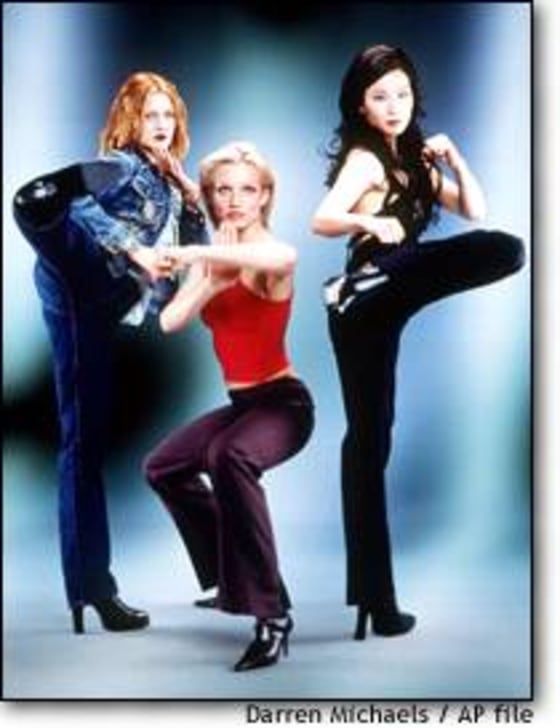Sarah Connelly is trying to get into better shape. But that’s not the only reason she recently took a kickboxing aerobics class at the Crunch gym in West Hollywood. “My husband really wanted me to take it because he wants me to be tough,” says Connelly, who just moved to the big city from Louisiana. So did the class instill some fighting power in her? “A little bit,” she chuckles.
After a rigorous hour filled with plenty of kicks and jabs, though, it’s the participants in the class who seem to be on the receiving end of any butt-kicking. “I’m not sure I’m going to be able to walk tomorrow,” Connelly says, half jokingly.
She is one of many women participating in popular martial arts-based fitness classes, according to industry sources. Helping to fuel the trend, they say, are the “girl power” images that abound in movies like “Kill Bill,” “Charlie’s Angels” and “The Matrix.”
“You’re seeing more women in the role of martial artist,” says Chalene Johnson, a fitness instructor in Laguna Hills, Calif.
Recreational exercisers may not be able to master all the moves like Uma Thurman or Lucy Liu do on the big screen — or want to. But they can have some fun trying.
“It’s almost like a fantasy when they get in that room,” Johnson says.
Kung Fu meets the bosu
Unlike more traditional kickboxing classes of the past, today’s martial arts fitness classes come with various twists that appeal to women. Known as martial arts fusion classes, they combine practices like karate with a range of other popular fitness modalities, such as yoga, step and body sculpting.
Johnson is the creator of Turbo Kick, a class that fuses elements of boxing, tai chi, yoga and hip hop. “We just don’t take ourselves so seriously,” she says.
The combinations can be as creative as the instructor dares. Connelly’s class, called Cardio Tai Box, combines high-impact cardio kickboxing with some mat Pilates during the cool-down.
POW!, a martial arts training and fitness center in Chicago, offers fusion classes that merge kung fu with yoga, Pilates and the BOSU, a dome that exercisers stand on for balance training.
And in Miami, Janis Saffell of Fitness Express International teaches Kickbox Step, which combines kickboxing with step aerobics, and Lethal Legs, a combo of tae kwon do and ballet.
Statistics from the IDEA Health and Fitness Association, an industry group, show that such martial-arts based classes have become increasingly popular in recent years. This year, 40 percent of gyms surveyed offer such classes, compared with 12 percent in 1997.
Battling boredom
But mixing things up is nothing new to the fitness industry, which is always looking for ways to keep clients interested — and moving.
“Consumers these days get bored pretty quickly,” says Kathie Davis, executive director of IDEA.
Davis says the martial arts fusion classes probably appeal to a lot of women who wouldn’t take a traditional karate class. “They’re not really interested in learning how to fight, but they think it sounds like fun,” she says.
And while men have traditionally shunned aerobics classes because of the dance elements, some are drawn to the martial arts varieties, Johnson says: “You never have a step-together, step-touch or anything that feels too ‘dancey.’”
Experts say the classes can provide a good all-around cardiovascular workout, along with stretching and strengthening if those elements are incorporated.
Start slowly
But it’s important to take appropriate precautions, particularly for beginners, who should start slowly and tell instructors if they’re new.
“Your typical novice exerciser doesn’t use the muscles that are used in the martial arts,” says Tony Ordas, a spokesperson for the American Council on Exercise who holds a black belt in karate. A bicyclist, for instance, doesn’t use the shoulders and hips as much as someone in a martial arts class.
Repetitive punching and kicking can place stress on joints and muscles, leading to overuse injuries, strains and sprains, he says, noting that “locking” the arms or knees can be particularly damaging.
Ordas recommends observing a class before taking it to make sure you know what’s involved and that you like the instructor’s style.
Also look for an instructor with solid credentials, advises Davis. “What concerns me are some of the weekend courses where all of a sudden the instructor has a certification in kickboxing,” she says. Ideally, choose someone with several years experience, she says.
Another important safety precaution: Make sure there’s enough room between you and the fighting machine next to you. She may not be able to inflict as much damage as a real kung fu fighter, but she can at least pretend — and get her heart pumping at the same time.
